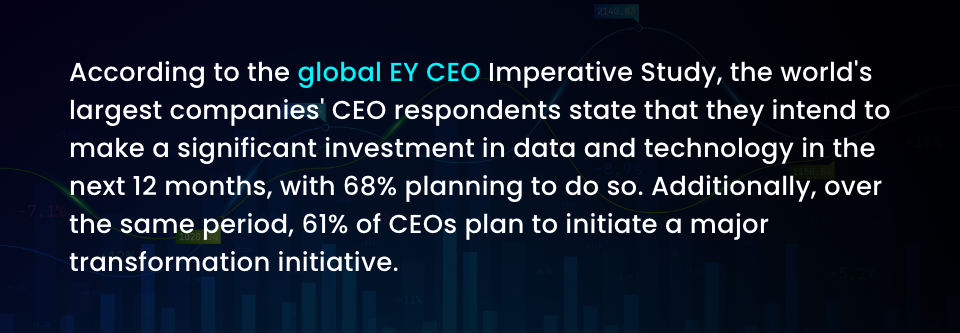Consumers’ expectations today are continuously driving the retail sector to build omnichannel experiences. Outstanding products go unnoticed unless supported with innovative and great customer experiences.
Traditional eCommerce technologies and systems are siloed and fail to offer customers a connected experience across the eCommerce lifecycle from manufacturing and supply chain till the digital store UX.
However, introducing digital transformation into an existing business with legacy industrial processes and infrastructure is not done at the drop of a hat. This requires careful study of what needs to be modernized, what to be introduced, and what to completely discontinue. Introducing new practices will take some time to trickle down right from the top management to the frontline workers. Adapting to new technology will require training for the workers.
How to Develop a Digital Transformation Strategy for eCommerce
Digital transformations demand a well defined roadmap strewn with defined milestones for short timelines. Let us look into some of the key steps in building a successful digital transformation strategy.
Digital transformation may fail or the adoption roadblocks if C-suite executives are not convinced enough. Without the management support not everyone can be brought on board.
Prepare the Leadership for Digital Transformation
To get the leadership convinced of the importance of adopting digital transformation it is important to show them the benefits.

According to the global EY CEO Imperative Study, the world’s largest companies’ CEO respondents state that they intend to make a significant investment in data and technology in the next 12 months, with 68% planning to do so. Additionally, over the same period, 61% of CEOs plan to initiate a major transformation initiative.
Point to Industry Trends
Factual information can get the leadership convinced about the need for digital transformation. Facts and stats can be collected from publications that conduct regular survey on consumers and keep an eye on emerging eCommerce trends and changing customer habits. Social media platforms like Linkedin and Twitter also show important changes in market trends.
Various eCommerce analyst pages and platforms offer valuable insights and predictions. Feedback from existing and potential customers through customer surveys can highlight business specific areas of improvement be it the application they are using or the user journey to buy something. Powerful business intelligence tools can be leveraged to extract maximum information from organizational data
Highlight ROI
The ROI of any new initiative is very important to motivate the business leaders to drive it. The C-suite managers need to know the benefits that will come from transferring their database to some cloud, or integration of a VR experience with the product.
To calculate the ROI there are some common overheads that need to be taken into account.
The cost of implementing the new technology including infrastructure setup and resources should be closely estimated to prevent any budget overrun.
Often adopting digital transformation leads to coming under the service umbrella of one large vendor and this can be a significant contributor in reduction of cost which comes usually with paying subscription fees to multiple third party services in case of a legacy system.
Other steps that can increase ROI is reduction of cost with new integrations, reduced expenses in data transfer, reduced time in gathering and analyzing data, increased transparency and synchronization in sharing of data.
Manage Talent and Build Digital Skills
The next step is to prepare the rest of the employees for digital transformation. To build digital skills of the existing workforce for the new tools and practices a training plan should be developed. This may include building familiarity with new point-of-sales system, inventory management software, CRM tools, and other retail specific digital solutions.
One aim of digital transformation in retail is to shift to omnichannel retailing. Employees need to be trained to understand and manage various channels such as e-commerce websites, mobile apps, social media, and in-store digital displays, to provide a seamless and consistent customer experience.
Data analytics is a key driver to digital transformation in retail. Various intelligence tools are used to unlock insights and make data driven decisions. Training is provided to employees to utilize these tools to identify trends, optimize inventory, and improve operational efficiency.
Training can be role specific often. While a person working in sales needs to be trained in a new kind of CRM another from the inventory management needs to get accustomed to some inventory analytics or supply chain management tool.
It is also at this point a roadmap is set about the insourcing and outsourcing of skilled talent for the transformation. The processes which are imminent to operations might not be left with enough time for training or the ROI on training may not be interesting. These tasks or processes can be assigned to a third party service provider with an exposure in a similar industry.
Change Management and Reinforcement
Digital transformation is not an event but a process where changes are introduced gradually in a managed environment. The value of digital transformation should be reinforced time and again to keep the stakeholders interested and not falling back to old practices.
Communication plays a vital role in the change management of an organization. Retail organizations need to communicate the vision, goals, and benefits of the transformation to employees at all levels. Regular updates, town hall meetings, newsletters, and intranet portals can be used to ensure transparent and consistent communication.
Leaders should actively support and promote the changes, acting as change agents. They need to demonstrate their commitment by embracing new technologies, participating in training programs, and providing guidance and support to employees during the transition.
Organizations can define new performance metrics that reflect the digital goals and reward employees who demonstrate proficiency in using digital tools, adapting to new processes, and achieving positive outcomes.
Conclusion
Change is what keeps a business in the game. Digital transformation in eCommerce brings in that freshness and agility to an existing process to win over new customers. Following a well thought out digital transformation strategy right from the start brings in that transition without much hiccups.
